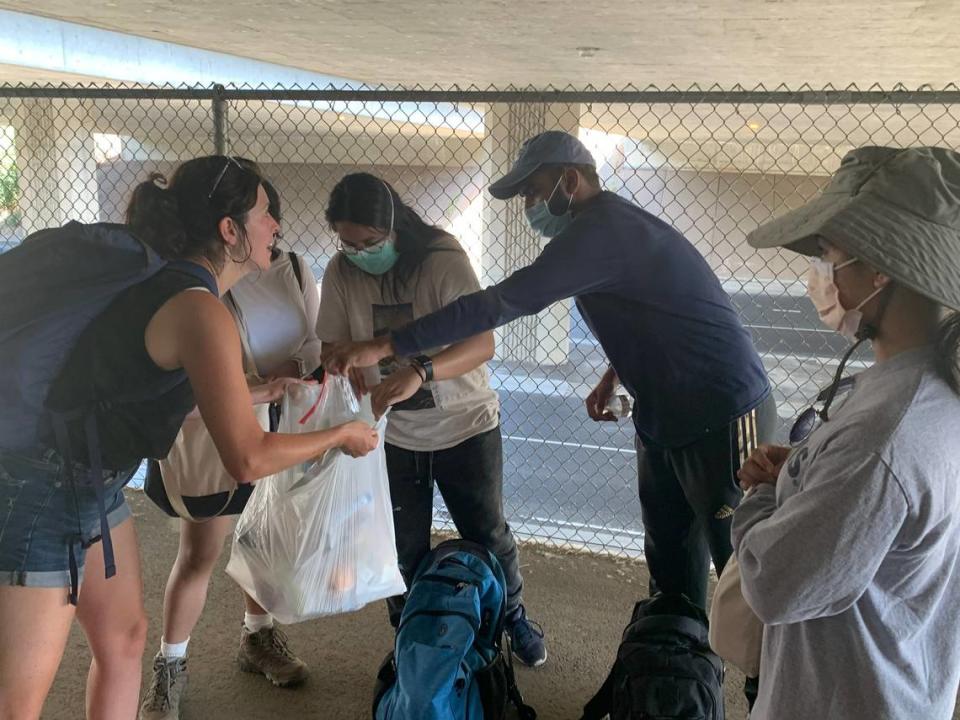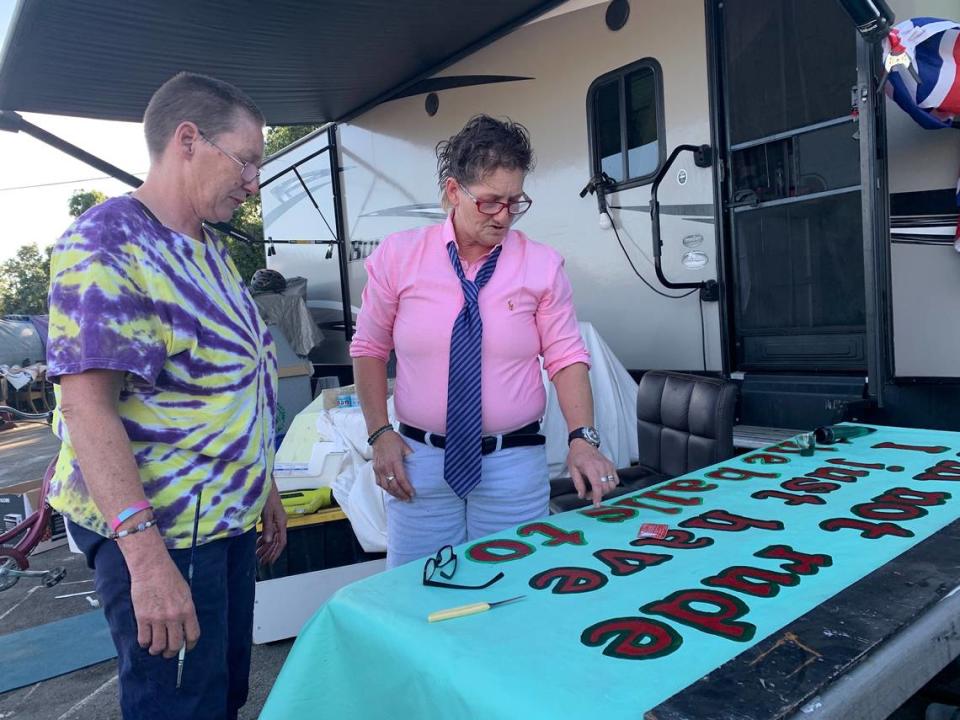Heat, floods and city sweeps: The reality of being unhoused in Sacramento’s extreme weather
- Oops!Something went wrong.Please try again later.
One stormy night in January, Joyce Williams and Sharon Jones were shaken awake by a fellow unhoused woman at an encampment near the Sacramento River.
They feared the floods would engulf them, their belongings and their dogs before they could escape.
“It was dark and the water was coming in fast and hard, and there was so much debris,” Williams said.
A married couple, Williams and Jones have endured seven challenging years of life on the street, regularly witnessing heart attacks, heat strokes and exposure to parasite-infested water — all while the threat of city sweeps loomed. Their situation was further worsened by extreme weather conditions, from rainstorms to heat waves.
“We’re doing the best we can,” Williams said. “We just go week by week.”
Heat warnings — and political pressure — across California have intensified, prompting cities like Sacramento to seek solutions to address both homelessness and a changing climate.
Sacramento broke records with extreme weather, facing both heat and floods last fall and winter. A statewide survey published by UC San Francisco in June noted that approximately 1% of nearly 3,200 participants lost housing due to “climate emergencies.”
“Homelessness, climate change, and health care are clearly intertwined with each other,” said Bob Erlenbusch, the executive director of the Sacramento Regional Coalition to End Homelessness. “People would be living longer if they weren’t living outside.”
Statewide, Gov. Gavin Newsom launched an expanded budget to fund climate resilience centers that target extreme heat waves, such as Sacramento’s Outreach and Engagement Center.
But funding gaps persist. Assemblymember Kevin McCarty, D-Sacramento, suggested the gap between the state budget and the average cost of housing per unhoused person is too vast.
“Permanent supportive housing … is like $600,000 per door and we have 171,000 homeless in California,” McCarty said. “171,000 homeless times $600,000 is like $100 billion.”
While legislators examine the fiscal reality, on-the-ground volunteers are putting in a sweat – literally.
“Knock knock! Sacramento Street Medicine!” said one of them. It was a 103-degree morning in early July. Volunteers with Sacramento Street Medicine, covered in sweat, had peered down an embankment near the Sacramento River where an encampment — referred to as Camp Gold by the volunteers — had been set up.
They had descended below street level into the partial cover of tree branches and bushes pulling wagons full of supply packs containing items like ACE bandages, hand sanitizer, socks, water, hydration packs and oranges.

“These people are survivors,” said Sam Sears, a volunteer lead. “I go out there for an afternoon in 100-degree weather and I feel like I’m going to die.”
Their main goal was to preserve ties after city sweeps and volatile weather fragmented encampments around the American River Parkway.
“I just wish they would stop the sweeps because it’s really hard for continuity of care,” said Sears. “So while the heat wasn’t as bad (this summer), it was a difficult summer to locate people and to reach people.”
An unhoused person living at Camp Gold shared they had been swept eight times in two weeks. But not all camps have to worry about city sweeps anymore.
In April, Williams and Jones secured a lease alongside other unhoused residents for the city’s first self-governing encampment — known as Camp Resolution — on an empty, public lot in the heart of California’s capital, equipped with a few generators that power most trailers.
Much of the climate protective equipment William and Jones have is self-financed — including $800 for an all-purpose weather tent and an additional $800 for the generator they’ve had for the last five years.
“For people with respiratory illnesses or diabetes or chronic heart conditions, there’s a lot of stress on their bodies from [intense weather],” said Joe Smith, a local nonprofit director and advocate. “There’s a lot of stress on their mind from the psychology of what they’re going through.”

Smith is program director of the Sacramento Outreach and Engagement Center, which opened in 2022 to provide unhoused people in the city’s district two relief, while also offering primary care and mental health services. Virtually half of those entering the pet-friendly center afterwards found more stable placement – whether sober living or long-term, according to Smith.
“It’s a sense of stability for people,” Smith said.
The Sacramento City Council unanimously voted on Aug. 1 to change activation criteria, now allowing the center to open during any National Weather System extreme weather event and when the air quality index reaches unhealthy levels.
Prior to the vote, temperatures needed to be above 100 degrees Fahrenheit for two days while not dipping below 75 degrees Fahrenheit at night.
Smith and other advocates had been calling for more flexible factors to allow for the center to open more frequently.
As the hottest months of the year wane, Smith reported the center has served 1,946 people since it first opened September of last year. Two hundred sixty-two of these people came for heat respite and 1,684 for cold weather respite.
“I’m glad that they modified the activation for the heat,” Smith said. “It did make it available for more days for the center to be open for weather respite, and in a perfect world, we would have 24-7 respite regardless of weather criteria.”
The center is 24-7 for general respite, accommodating up to 50 unhoused people. The center must meet weather activation criteria to accommodate an additional 50 unhoused people.
Last September’s heat wave broke records in downtown Sacramento, with temperatures spiking at 116 degrees. This September, the hottest temperature was 20 degrees less.
“As someone who’s lived outside, even a day can be dangerous,” Smith said, who was homeless between 2005 and 2011.
In May, a Sacramento Grand Jury called the city’s past homelessness solutions ineffective.
Assemblymember McCarty, along with three other legislators, proposed a joint powers authority to “triage” homeless solutions going forward. This authority would consist of officials from both the city and county of Greater Sacramento to centralize and accelerate initiatives and funding to address homelessness.
“We’re all in this together,” McCarty said. “A community, government — we can’t solve it with just one person,” adding that the joint response involves congregate centers, tiny homes, secure parking and more.
For now, advocates pose Camp Resolution as a model.
Camp Resolution’s lease agreement allows the group of roughly 50 unhoused people to live on the lot without the fear of being swept until each individual is housed.
“Camp Resolution is a really great transition and it could potentially be the future of how California can go about dealing with the housing crisis,” Sears said.
Additional reporting by Emma Canillo. Sarah Yee and Emma Canillo are reporters with JCal , a collaboration between The Asian American Journalists Association and CalMatters to immerse high school students in California’s news industry.

